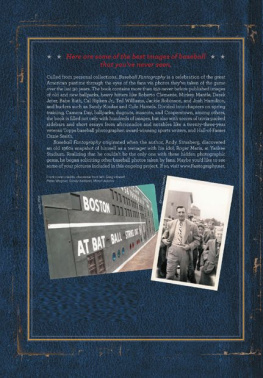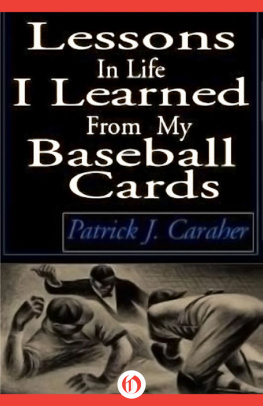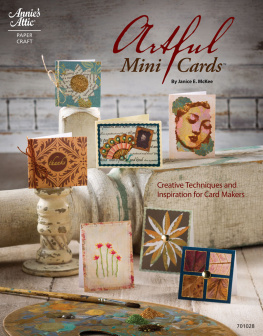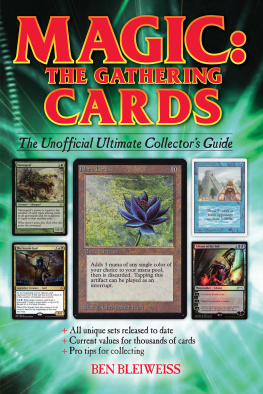
Mint Condition
Mint Condition
How Baseball Cards Became an American Obsession
DAVE JAMIESON

Copyright 2010 by Dave Jamieson
All rights reserved. No part of this book may be reproduced in any form or by any electronic or mechanical means, including information storage and retrieval systems, without permission in writing from the publisher, except by a reviewer, who may quote brief passages in a review. Scanning, uploading, and electronic distribution of this book or the facilitation of such without the permission of the publisher is prohibited. Please purchase only authorized electronic editions, and do not particiate in or encourage electronic piracy of copyrighted materials. Your support of the authors rights is appreciated. Any member of educational institutions wishing to photocopy part or all of the work for classroom use, or anthology, should send inquiries to Grove/Atlantic, Inc., 841 Broadway, New York, NY 10003 or permissions@groveatlantic.com.
The author would like to thank The Topps Company, Inc., and The Upper Deck Company, LLC for permission to reproduce their card images.
Published simultaneously in Canada
Printed in the United States of America
ISBN: 978-0-8021-9715-3 (e-book)
Atlantic Monthly Press
an imprint of Grove/Atlantic, Inc.
841 Broadway
New York, NY 10003
Distributed by Publishers Group West
www.groveatlantic.com
In memory of Brian Fleury and Matthew Morahan
Contents
Introduction
In the summer of 2006, my parents sold my boyhood home in northern New Jersey. With the new owners eager to move in, I had about three weeks to get home and clear everything out of my old bedroom. This would be no small task. Id gone through a few hard-core collecting phases in my younger daysAbsolut vodka magazine advertisements, Star Wars toysand Id for years declined to dispose of any of my accumulated trinkets. Perhaps I was deluded enough to believe that my beat-up Millennium Falcon would bring in some money one day, but I suspect I clung to these knickknacks for reasons more nostalgic than financial. After all, they were mementos of my formative years. When I told my mother that Id drive from Washington, D.C., to Jersey and back in a rental car, she worried that one particular boxful of memories might not be able to make the return trip. Youve gotta see this thing, she said. Its huge.
The object in question sat impressively in the middle of my bedroom closet, so large it seemed as if the rest of the house had been built around it twenty-odd years ago. Strewn atop and behind it were other remnants of my childhood: three Notre Dame football jerseys, one of them autographed by wide receiver Raghib Ismail; a Darth Vader helmet and an Ewok village; assorted Don Mattingly posters; and a circa 1988 Playboy of unknown provenance. The box itself was so heavy that at first I thought it held my old Weider dumbbells from middle school, but then I noticed the block letters Id markered on the side: BASEBALL CARDS.
This was my old stash: thousands, if not tens of thousands, of cards, most of them from the late 1980s, stuffed into shoe boxes. Kirby Puckett, Ryne Sandberg, and a presteroidal Barry Bonds all stared back at me with fresh young faces. Id started collecting these cards simply because I loved the game and idolized its players. But like many kids of my generation, I gradually came to believe that there was money at stake in trading cards. A Rickey Henderson rookie card could fetch $80 back then, and for an eight-year-old that kind of sale was like adding an extra Christmas to the calendar. I remembered this when I found, amid the untold number of common cards in my closet, two small black boxes that contained the gems of my collection, rookie cards of the games top players from two decades ago, all of them in fine condition and encased in plastic holders. So long, old friends, I thought. The time had come to cash in these long-held investments. After a few more moments of reverie, I decided to load every last card into my rental, haul them back to Washington, and put them up for sale.
There were so many cards that I couldnt fit them all into the trunk of the Civic; I had to load the spillover into the back seats. Once I got home, I realized that my modest studio apartment couldnt hold all of the cards, either. Rather than rent storage space, I decided to borrow a hand truck from the buildings maintenance guy and wheel them to my newspaper office a few blocks away. As my trove teetered down the sidewalk, the topmost shoe box fell to the pavement and a mess of cards spilled into the view of passersby. Lest these strangers believe that a twenty-seven-year-old man still collected baseball cards, I fumbled to get them back into the box as quickly as possible and continued on my way. Once at the office, I filled every square inch of free space in my cubicle with the cards, stuffing most of them beneath my desk. As I made phone calls, my knees bumped against the likes of Mark McGwire and Ken Griffey Jr. The joke in the newsroom was that Id brought in the cards just to be close to them.
Getting my collection to Washington turned out to be the easy part. Unloading the cards on someone else would prove nearly impossible. I tried the phone numbers of card dealers Id found online, but they all seemed to be disconnected. Not a good sign. Finally, I reached a human. Ive got a load of good cards Im looking to get rid oflots of nice rookies, I told the man confidently.
When are they from? he asked.
The eighties, mostly, I said.
Those cards arent worth anything, he told me, declining to look at them.
I tried another shop that still seemed to be in business. I was told, Maybe if you had, like, twenty McGwire rookie cards, thats something we might be interested in.
Have you tried eBay? asked the third dealer I got in touch with.
I duly checked the site, and I was shocked to see the going rates for my cards. On Craigslist the market looked even worse. The collectibles-for-sale board was littered with postings from clueless card holders like myself, who were pushing thirty and suddenly had to sell off a 1988 Fleer factory set. Under titles such as tens of thousands of baseball cards for sale! and I am selling thousands and thousands of baseball cards, the lapsed collectors all but pleaded for buyers to haul the twenty-year-old cardboard out of their homes. I need to make room, they implored.
Still, just about all of these postings ended with what I now knew was a hilariously untenable asking price. One guy wanted $1,500 for his ten thousand cards. He didnt understand: we all still had our ten thousand cards. I sent teaser e-mails to some of the sellers. I was accustomed to getting no response in Craigslist dealings, but I heard back immediately from just about all of the card sellers I reached out to, even if their postings had been putrefying on the board for nearly a week. Yeah, man, theyd reply. Still got em. When do you wanna come by? Im here all day... Nobody wanted these things, and nobody could get rid of them, either. The baseball card market had apparently collapsed.
I headed to a nearby CVS to get a look at the latest card offerings, wondering if perhaps some deterioration in quality was to blame. I walked aisle after aisle in vain. Where are your baseball cards? I finally asked a young clerk.
Next page










